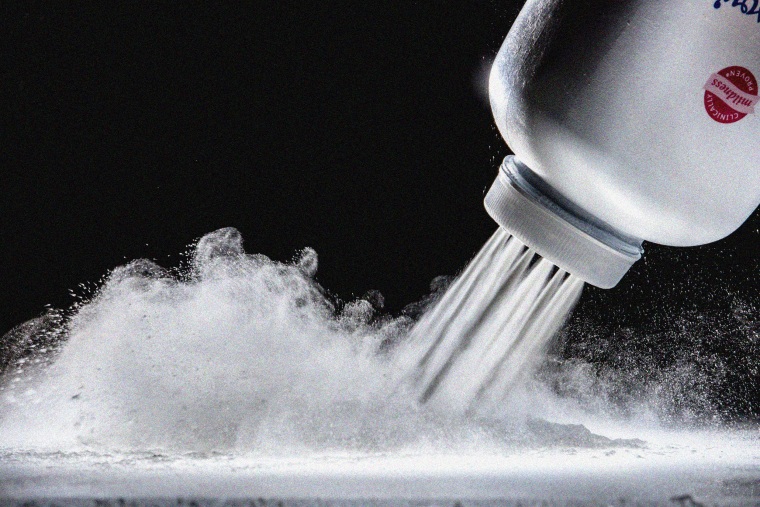New research published this week lends credence to the more than 50,000 lawsuits against Johnson & Johnson that allege its talc-based baby powder caused ovarian cancer.
The analysis, released Wednesday in the Journal of Clinical Oncology, found that applying talc powder to the genitals was associated with ovarian cancer — and that the association was greater for people who used the powder frequently or for long periods of time.
The researchers are from the National Institutes of Health, and their findings were based on data from the Sister Study, which enrolled more than 50,000 women in the U.S. from 2003 to 2009. The participants joined when they were between 35 and 74 years old, and each had a sister who’d been diagnosed with breast cancer, which might put them at increased risk for breast or ovarian cancer.
Lawsuits related to J&J’s talc-based baby powder date back to 1999, when a woman alleged that a lifetime of using it led to her mesothelioma, a rare cancer usually caused by exposure to asbestos — a known carcinogen. In 2009, another woman sued the company, alleging that its talc-based products caused her ovarian cancer. Since then, many thousands of others have filed claims over cases of ovarian cancer or mesothelioma that they say were caused by asbestos in J&J baby powder.
J&J has stood by the safety of its talc products and denies that they ever contained asbestos. The company has also argued that studies have not demonstrated a convincing link between ovarian cancer and talc-based products.
The new research could undermine that line of reasoning as the legal battles continue. Most of the lawsuits against J&J have been consolidated into a single federal case in New Jersey, with trial scheduled for December.
“This study is quite timely. We feel like it completely affirms and confirms the position taken by plaintiffs’ experts,” said Leigh O’Dell, a principal at Beasley Allen Law Firm. O’Dell is the co-lead counsel for the plaintiffs’ steering committee, a group of attorneys appointed to act on behalf of the many people with pending cases against J&J.
However, Erik Haas, J&J’s worldwide vice president of litigation, said the new analysis doesn’t establish causality or implicate a specific cancer-inducing agent.
“This study does not change the overwhelming evidence that talcum powder does not cause ovarian cancer,” he said.
Earlier this month, J&J proposed a payment of around $6.48 billion to resolve the lawsuits, but the deal would involve moving the cases to bankruptcy court and require 75% of claimants to vote in favor.
J&J has tried and failed twice to resolve talc lawsuits in bankruptcy court. The company created a subsidiary in 2021 that could assume liability for talc-related legal claims — a legal maneuver known as a Texas two-step. But thus far, courts have dismissed the bankruptcy filings on the grounds that the subsidiary is not in financial distress.

O’Dell said her team “would like to see these women offered a reasonable and fair resolution outside of bankruptcy.”
“Any effort to file another bankruptcy, we believe, is just yet another abuse of the bankruptcy system,” she said.
The potential harms of talc products
The new study asked women how often they used talc powder on their genitals from ages 10 to 13 and during the year before they enrolled in the study. NIH researchers followed up with surveys from 2017 to 2019 that asked women about their lifetime use of talc powder.
Based on the responses, the researchers estimated that up to 56% of the women used talc powder on their genitals at some point. These women were more likely to be Black, less educated and live in the South compared with people who didn’t use talc powder.
The analysis can’t prove that talc causes ovarian cancer, nor does it identify a brand or chemical driving the association. Dale Sandler, one of the study’s authors and the chief of the epidemiology branch at the National Institute of Environmental Health Sciences, said there probably isn’t a way to prove causality in human studies.
“You can’t do a clinical trial and randomize people to ‘powder’ and ‘no powder.’ So we’re going to need to look to other types of research,” she said.
At the very least, the findings should prompt women to rethink their use of talc products, said Katie O’Brien, the lead author of the analysis and an epidemiologist at the National Institute of Environmental Health Sciences.
“We’re not aware of any medically necessary reasons why someone would need to use talcum,” she said.
Current formulations of J&J baby powder use cornstarch, not talc. The company pulled the talc-based versions from the North American market in 2020, citing waning demand and “misinformation around the safety of the product,” and discontinued the product internationally last year.
Talc and asbestos are found in close proximity in nature, so some raw talc collected via mining may be contaminated with asbestos, according to the Food and Drug Administration.
A 2018 Reuters investigation suggested that J&J knew some of its baby powder was contaminated with small amounts of asbestos as early as the 1970s. But J&J denies asbestos was ever present in its products.
O’Brien said asbestos might not be the only reason for an association between talc and cancer. Some talc products may also contain phthalates — chemicals that disrupt hormones in the body and have been linked to ovarian cancer. Plus, talc itself can be abrasive, she added, so it may cause inflammation in the areas where it’s applied. Inflammation is independently associated with the development of cancer.
A debate over the science
Debates over the research linking talc and ovarian cancer will almost certainly be a focus of upcoming litigation in the J&J case.
The New Jersey federal court ruled in March that the company can contest findings that link ovarian cancer to talc.
To support its position, J&J has pointed to research that O’Brien and Sandler published in 2020, which did not find a statistically significant association between ovarian cancer and the use of talc powder.
But O’Brien said that older study may not have been set up to detect small changes in risk because it did not ask women about their lifetime use or factor in the chance that people might misremember their past habits. Sandler said the new study accounts for those two variables.
“This newer analysis sort of tips the balance by accounting for all these possible ways that reporting could have been incomplete in the prior literature,” she said.
How talc may have played into body shame
J&J started selling talc-based baby powder in 1894.
Although many women have used it to keep their genitals dry, there’s no need to use powder to get rid of moisture in that area, said Alexandra Scranton, director of science and research at Women’s Voices for the Earth, a nonprofit that aims to eliminate chemicals that negatively affect women’s health.
“Moisture in this part of the body is a very healthy thing,” Scranton said. “This part of the body is covered in mucous membranes. It’s supposed to be moist.”
According to O’Brien’s research, some women in the 2000s — often those in their 20s and 30s — also used talc powder on their genitals to feel clean and reduce odor. That application isn’t advised by health experts, either, since the vagina is self-cleaning and good bacteria inside of it naturally produce a slight odor.
Companies like J&J were “basically creating and promoting this myth that this part of your body — your genitals, your vagina — are inherently dirty and that they’re inherently odorous, and therefore inherently shameful,” Scranton said.
J&J said it disagrees with that characterization.
Some women continue to use baby powder on their genitals or have adopted new products like vaginal washes or scented body deodorants.
“It’s so ingrained and so part of the way they take care of their bodies that they can’t imagine not doing it,” Scranton said. “They’ve got their mom’s voice in their head: ‘This is what you do to be a respectable woman.’”

